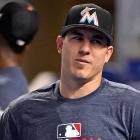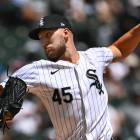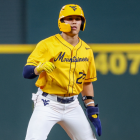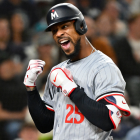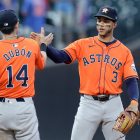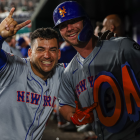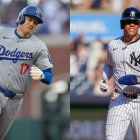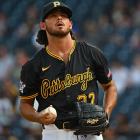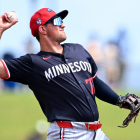The Phillies and Marlins on Thursday completed a trade that sends All-Star catcher J.T. Realmuto to Philly in exchange for catcher Jorge Alfaro, right-handed prospect Sixto Sanchez, left-handed prospect Will Stewart and $250,000 in international signing bonus slot money. With the details laid out, let's get to grading the trade.
Phillies: A
The Phillies have already been pretty active by the standards of the 2018-19 offseason, as they've signed Andrew McCutchen and David Robertson and traded for Jean Segura. Now Realmuto constitutes a big upgrade behind the plate. He's of course coming off a stellar 2018 ...
Going into his age-28 campaign, Realmuto boasts a career OPS+ of 111, and his 2018 work shows he's capable of even more than that. As well, the advanced defensive metrics grade him as a plus behind the plate. For the Phillies, the hope is that Realmuto with the bat can come close to replicating his breakout work of last season. In 2018, Realmuto increased his fly-ball percentage modestly while also making significant strides with his rate of hard-hit balls, which are both good signs moving forward.
Now we'll turn to an advanced metric called expected weighted on-base average (xwOBA). This metric grows out of wOBA, which assigns proper value to every possible offensive event that happens while a batter is at the plate. Those proper valuations of singles, doubles, homers, walks, etc., distinguish wOBA from more traditional measures like AVG, OBP, and SLG. Also, for simplicity wOBA is scaled to look like OBP, which means that, say, .400 is elite and .290 is pretty poor. For instance, Babe Ruth is the all-time leader with a patently absurd wOBA of .513.
All of that brings us back to xwOBA, which is an estimation of what a hitter's wOBA should be based on things like exit velocity off the bat and launch angle. What xwOBA does is attempt to strip away luck -- bad or good -- and defensive play from wOBA and identify a hitter's baseline skill. It's useful for getting an idea of how a hitter figures to perform in the near-term future. Basically, if a hitter's xwOBA is significantly lower than his wOBA, he's probably going to come back to earth at some point.
As for Realmuto, in 2018 he put a wOBA of .353. Meantime, his xwOBA checked in at .350. That's a mostly insignificant margin, and that means his 2018 offensive breakout was mostly reflective of skills growth as opposed to good fortune. This, obviously, is good news for the Phillies.
Realmuto is also not eligible for free agency until after the 2020 season, so for the next two years the Phillies may have on their roster the best catcher in all of baseball. Beyond that? There's hope from the Philly side ...
Realmuto turns 28 in March. He's under club control for two more seasons. He was not open to extension talks with Miami, but two sources said those talks are expected to happen with Phillies.
— Matt Gelb (@MattGelb) February 7, 2019
For this to truly be an A move, though, the Phillies still need to put the capstone on their offseason by signing Bryce Harper or Manny Machado -- their stated goal for some time. The NL East is looking like a pretty brutal circuit in 2019, and for the Phils to truly make the leap to favorite over the Braves, Nationals and retooled Mets, they need one of the two signature free agents. Realmuto's addition no doubt makes the Phils more attractive to those two talents.
On another level, the Phillies landed Realmuto without having to part with shortstop Luis Garcia, who may have the highest upside in the entire system.
Marlins: C-minus
A little perspective on this meandering Realmuto journey ...
An idea of how far #Marlins went in this process: when #Yankees earlier this offseason were trying to get Realmuto to spin to #Mets for Syndergaard, Mia requested Gary Sanchez and Miguel Andujar.
— Joel Sherman (@Joelsherman1) February 7, 2019
Sure, that's just an ask, but that it was a plausible ask suggests that the Marlins may have let this one bake too long. As for the return they wound up with, it's not impressive. Alfaro can hit a little by the standards of catchers, and he showed broad-based growth defensively last season. However, he's just a little more than two years younger than Realmuto. It's possible he'll make a leap forward on the Marlins' watch, but they're so deeply torn down that Alfaro may be past whatever prime is ahead of him by the time the Marlins are relevant again.
As for Sanchez, he immediately becomes the Marlins' top prospect, but that's a relative matter. Consider:
16 months ago the Marlins had Yelich, Stanton, Ozuna, and Realmuto in a winnable division and *poof*
— Mike Axisa (@mikeaxisa) February 7, 2019
The Marlins traded away all that and more while netting at most three consensus top-100 prospects. That's a remarkable feat of sorts, and it hearkens back to the idea that Alfaro may be on a downward flume by the time the Marlins are non-terrible. As for Sanchez, he's got the big fastball, but that's about it. The secondary offerings need work, hitters timed up his fastball pretty well last season, and his slight build raises concerns about stamina and future injury risk. In other words, he's a pitching prospect, and farm systems built upon young arms so often disappoint. Stewart is a deep-repertoire sort with no plus pitches who hasn't pitched above Low-A.
And with that the Marlins have pretty much traded away all their veteran assets, and they have a middling farm system to show for it. The most realistic hope in this one is that Alfaro develops in time to be flipped for, one hopes, something more than this.











